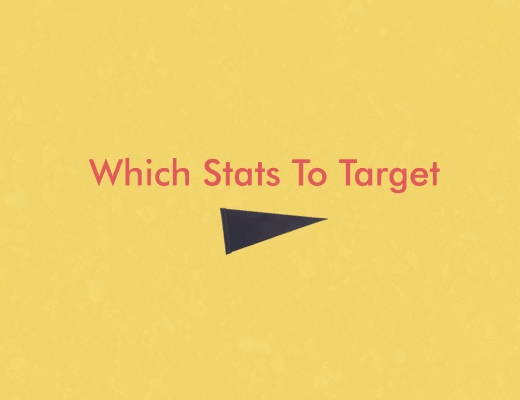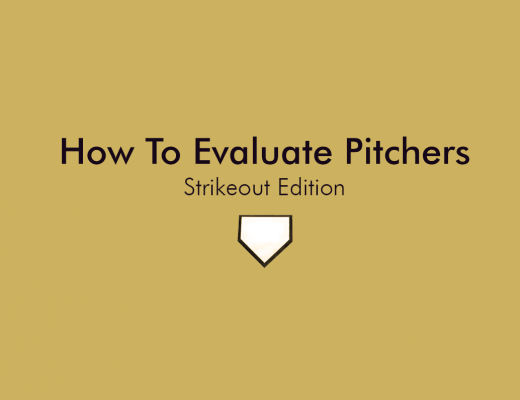When it comes to evaluating hitters for your fantasy baseball leagues, there are generally five statistics that are focused on as they are the basic statistics of most roto leagues (AVG, HR, RBI, R and SB). In order to possibly predict what those numbers would be in an upcoming season, we have to rely on looking at past performances to see what those wacky stats tell us. Luckily, baseball has a lot of advanced statistics that are helpful in determining whether those five base numbers are going to maybe go up or go down in this next year.
A hitter has control over whether they hit a ball or not and how the ball is hit but there’s a lot of luck involved after that point. When evaluating a hitter, we need to account for such luck when guessing about what will happen in the future. Unfortunately, the thing we can’t account for is more good or bad luck in the upcoming season but we can still make a darned good evaluation of a hitter by using some of the more advanced metrics.
I will go over how to evaluate these statistics over this series of blog posts. This first one here is about evaluating a hitter’s batting average.
Batting Average
Batting average is the statistic that can be most prone to some luck due to the fact that whether a batted ball lands in a player’s glove or a few feet in front of it can be a bit random. When looking at a player’s batting average, these statistics can be helpful for poking at a batting average to see how much luck was involved: BABIP, xBABIP and xAVG.
BABIP (Batting Average on Balls in Play) is the entry level statistic for evaluating whether a hitter’s batting average will be able to be reproduced in the future. BABIP measures the batting average only on plays where the ball is hit into the field (ignoring strikeouts, walks and homeruns for instance). Without luck or speed involved, the “normal” batting average for balls hit into play (BABIP) for a hitter is about .290. Sometimes a player has a BABIP well above .290 which usually indicates that they’re getting lucky.
To understand why BABIP and luck go together like birds of a feather, let’s think of flipping a coin. Statistically the coin should land on heads 50% of the time. You could flip that coin 100 times and, call it luck or whatever you want, but it could land on heads 65% of the time. Instead of looking at the 65% rate, you still realize that the expected rate is 50% and you’d put money on that coin landing on heads at less then 65% over the next 100 flips. In terms of BABIP, we expect 29% of balls hit into play to actually become hits just like expect 50% of coin flips to land on heads. But, sometimes it doesn’t go that way and we need to recognize that and if 40% of balls that went into play became a hit (thus raising a player’s AVG) then the smart money is to bet on that batting average dropping.
Example: Player A’s AVG was .300 in 2011 but his BABIP was .340. The league average BABIP is .290 so Player A has been getting more hits on balls in play than expected and his AVG is inflated. Player A probably won’t hit for .300 next year without more luck.
That’s BABIP on the surface but it goes deeper than that. While .290 is the league average BABIP, each player is different. If a player hits a lot of line drives then his BABIP will be different than someone who hits a ton of groundballs because each batted ball type has a different likelihood of becoming a hit. A player like Ichiro Suzuki might always have a BABIP that is always around .330 because of how he hits and runs. Even though the average BABIP is .290, Ichiro is not getting lucky since he hits the ball in ways that are more likely to become hits. In order to account for that, there is a statistic called xBABIP.
xBABIP (Expected Batting Average on Balls in Play) is the advanced level statistic for evaluating batting average. It attempts to come up with an expected BABIP for a player (replacing that .290 figure from above). Keep in mind that there are a few variations of the formula for this stat out there and they each differ slightly. Currently the more recognized version was done at Beyond The Boxscore and it takes GB%, FB%, LD% as well as IFFB%, IFH% and HR/FB% to calculate the type of BABIP a player should have. A hitter who hit lots of line drives may be expected to have a .320 BABIP since line drives turn into hits more often and a fly ball hitter may have an xBABIP of .275. The formula takes those hit types into account and generates an xBABIP for each player based on their batted ball profile.
Example: Player A’s AVG was .300 in 2011 but his BABIP was .340. His xBABIP was .330 so Player A has only been getting a few more hits on balls put into play than he should have. Player A’s AVG may go down slightly in 2012 but not by much.
The beauty of this is that we could even calculate an expected number of hits and then an expected batting average for a player based on xBABIP if we so desired. That would really let us drill down to see just how lucky someone was. In fact, let’s do that…
xAVG (Expected Batting Average) would be the expert level analysis tool but, ironically, ends up being the easiest to understand once generated. There isn’t a site that has this readily available but using xBABIP we can calculate an xAVG like this: (HR+xBABIP*(AB-K-HR+SF))/AB. It’s not pretty but it takes the expected BABIP to figure out the expected number of hits and then divide that by AB’s. While it’s a pain in the butt to gather, it gives you a situation where you can say “In 2011, Alex Avila’s expected average was .269 but he hit .295 so his average should be closer to .269 in 2012.” And, that sounds a heck of a lot nicer than “In 2011, Alex Avila hit .295 but had a BABIP of .366 which was well above his expected BABIP of .329 so his average should drop by some amount in 2012.” Instead of you digging up all of that info yourself since it’s not readily available anywhere, I’ve calculated the 2011 season xAVG versus AVG for all players and posted it here: Google Docs Link
So there you have it, you can look at a player’s batting average now and tell someone whether you think it’s legit or not. Go ahead to your local sports pub and talk about batting averages with all the patrons. Watch the normal sports fan’s fist fly into your face as the words “expected BABIP” come out of your mouth! Fun times for all!



Joe Dacquisto
03/04/2013 at 3:10 AMThis comment has been removed by the author.